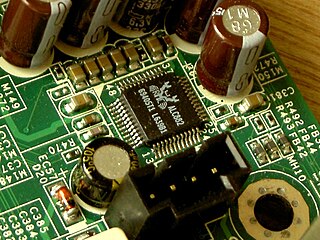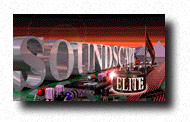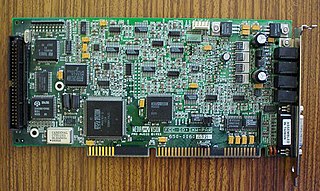
A sound card is an internal expansion card that provides input and output of audio signals to and from a computer under the control of computer programs. The term sound card is also applied to external audio interfaces used for professional audio applications.

Sound Blaster is a family of sound cards and audio peripherals designed by Singaporean technology company Creative Technology. The first Sound Blaster card was introduced in 1989.
AC'97 is an audio codec standard developed by Intel Architecture Labs and various codec manufacturers in 1997. The standard was used in motherboards, modems, and sound cards.

The Gravis UltraSound or GUS is a sound card for the IBM PC compatible system platform, made by Canada-based Advanced Gravis Computer Technology Ltd. It was very popular in the demoscene during the 1990s.

The Covox Speech Thing is an external digital-to-analog converter (DAC) that plugs into the parallel printer port of a PC. It converts 8-bit digital sound using a simple R-2R resistor ladder into an analog signal output.

Intel High Definition Audio (IHDA) (also called HD Audio or development codename Azalia) is a specification for the audio sub-system of personal computers. It was released by Intel in 2004 as the successor to their AC'97 PC audio standard.

There have been various families of Yamaha audio controllers labelled as YMF7xx.

Sound Blaster X-Fi is a lineup of sound cards in Creative Technology's Sound Blaster series.

Soundscape S-2000 was Ensoniq's first direct foray into the PC sound card market. The card arrived on the market in 1994. It is a full-length ISA digital audio and sample-based synthesis device, equipped with a 2 MiB Ensoniq-built ROM-based patch set. Some OEM versions of the card feature a smaller 1 MiB patch set. It was praised for its then-high quality music synthesis and sound output, high compatibility and good software support.

The Ensoniq Soundscape OPUS (SS-3016-NCD) is a Gateway 2000 OEM sound card, and possibly was used by other OEMs, but was never sold to Ensoniq's customers directly. It was a Soundscape-like board, using the Ensoniq "OPUS" multimedia sound chip that only was used on these OEM boards. It had a 1MB patch set ROM chip, resulting in a lesser MIDI quality compared to the Soundscape and Soundscape ELITE. The "OPUS" cards again carry the Motorola 68EC000 CPU. The variety of CD-ROM interfaces have been removed. Otherwise, however, the card is simply a cost-reduced Soundscape-compatible board with similar capabilities.

The Soundscape Elite was Ensoniq's high-end ISA PC sound card offering. It offers the highest MIDI quality of any PC sound card Ensoniq produced. The board is an evolution of the company's previous Soundscape S-2000. The Soundscape ELITE was launched in March 1995.

The Ensoniq AudioPCI is a Peripheral Component Interconnect (PCI)-based sound card released in 1997. It was Ensoniq's last sound card product before they were acquired by Creative Technology. The card represented a shift in Ensoniq's market positioning. Whereas the Soundscape line had been made up primarily of low-volume high-end products full of features, the AudioPCI was designed to be a very simple, low-cost product to appeal to system OEMs and thus hopefully sell in mass quantities.

Sound Blaster Live! is a PCI add-on sound card from Creative Technology Limited for PCs. Moving from ISA to PCI allowed the card to dispense with onboard memory, storing digital samples in the computer's main memory and then accessing them in real time over the bus. This allowed for a much wider selection of, and longer playing, samples. It also included higher quality sound output at all levels, quadrophonic output, and a new MIDI synthesizer with 64 sampled voices. The Live! was introduced in August 1998 and variations on the design remained Creative's primary sound card line into the early 2000's.

Sound Blaster Audigy is a product line of sound cards from Creative Technology. The flagship model of the Audigy family used the EMU10K2 audio DSP, an improved version of the SB-Live's EMU10K1, while the value/SE editions were built with a less-expensive audio controller.

The Sound Blaster 16 is a series of sound cards by Creative Technology, first released in June 1992 for PCs with an ISA or PCI slot. It was the successor to the Sound Blaster Pro series of sound cards and introduced CD-quality digital audio to the Sound Blaster line. For optional wavetable synthesis, the Sound Blaster 16 also added an expansion-header for add-on MIDI-daughterboards, called a Wave Blaster connector, and a game port for optional connection with external MIDI sound modules.

The Sound Blaster AWE32 is an ISA sound card from Creative Technology. It is an expansion board for PCs and is part of the Sound Blaster family of products. The Sound Blaster AWE32, introduced in March 1994, was a near full-length ISA sound card, measuring 14 inches (356 mm) in length, due to the number of features included.

The Media Vision Pro AudioSpectrum family of personal computer sound cards included the original 8-bit Pro AudioSpectrum (1991), the 8-bit Pro AudioSpectrum Plus, 16-bit Pro AudioSpectrum 16, Pro AudioSpectrum 16 Basic and 16-bit Pro Audio Studio. All PAS cards with the exception of Pro AudioSpectrum 16 Basic could connect to CD-ROM drives—variants having SCSI or various proprietary interfaces—and many were sold in multimedia kits with compatible CD-ROM drives.

E-mu Systems was a software synthesizer, audio interface, MIDI interface, and MIDI keyboard manufacturer. Founded in 1971 as a synthesizer maker, E-mu was a pioneer in samplers, sample-based drum machines and low-cost digital sampling music workstations.

The Sound Blaster X7 is a USB audio device that can work without a computer. It was announced on 3 September 2014. It supports Microsoft Windows and Mac OS X computers but requires a power supply to work. The Sound Blaster X7 has the SB-Axx1 sound chip built-in. Android and iOS devices can change SBX Pro Studio audio settings with the Sound Blaster X7 Control app.



















